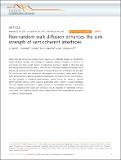| dc.contributor.author | Jourdan, T. | |
| dc.contributor.author | Marinica, M.-C. | |
| dc.contributor.author | Vattre, A. | |
| dc.contributor.author | Ding, Hepeng | |
| dc.contributor.author | Demkowicz, Michael J. | |
| dc.date.accessioned | 2016-03-25T14:06:51Z | |
| dc.date.available | 2016-03-25T14:06:51Z | |
| dc.date.issued | 2016-01 | |
| dc.date.submitted | 2015-06 | |
| dc.identifier.issn | 2041-1723 | |
| dc.identifier.uri | http://hdl.handle.net/1721.1/101868 | |
| dc.description.abstract | Clean, safe and economical nuclear energy requires new materials capable of withstanding severe radiation damage. One strategy of imparting radiation resistance to solids is to incorporate into them a high density of solid-phase interfaces capable of absorbing and annihilating radiation-induced defects. Here we show that elastic interactions between point defects and semicoherent interfaces lead to a marked enhancement in interface sink strength. Our conclusions stem from simulations that integrate first principles, object kinetic Monte Carlo and anisotropic elasticity calculations. Surprisingly, the enhancement in sink strength is not due primarily to increased thermodynamic driving forces, but rather to reduced defect migration barriers, which induce a preferential drift of defects towards interfaces. The sink strength enhancement is highly sensitive to the detailed character of interfacial stresses, suggesting that ‘super-sink’ interfaces may be designed by optimizing interface stress fields. Such interfaces may be used to create materials with unprecedented resistance to radiation-induced damage. | en_US |
| dc.description.sponsorship | United States. Dept. of Energy. Office of Nuclear Energy (Contract DE-NE0000533) | en_US |
| dc.description.sponsorship | United States. Dept. of Energy (National Energy Research Scientific Computing Center (U.S.)) | en_US |
| dc.description.sponsorship | National Science Foundation (U.S.) (Grant 1150862) | en_US |
| dc.language.iso | en_US | |
| dc.publisher | Nature Publishing Group | en_US |
| dc.relation.isversionof | http://dx.doi.org/10.1038/ncomms10424 | en_US |
| dc.rights | Creative Commons Attribution | en_US |
| dc.rights.uri | http://creativecommons.org/licenses/by/4.0/ | en_US |
| dc.source | Nature Publishing Group | en_US |
| dc.title | Non-random walk diffusion enhances the sink strength of semicoherent interfaces | en_US |
| dc.type | Article | en_US |
| dc.identifier.citation | Vattré, A., T. Jourdan, H. Ding, M.-C. Marinica, and M. J. Demkowicz. “Non-Random Walk Diffusion Enhances the Sink Strength of Semicoherent Interfaces.” Nat Comms 7 (January 29, 2016): 10424. | en_US |
| dc.contributor.department | Massachusetts Institute of Technology. Department of Materials Science and Engineering | en_US |
| dc.contributor.mitauthor | Ding, Hepeng | en_US |
| dc.contributor.mitauthor | Demkowicz, Michael J. | en_US |
| dc.relation.journal | Nature Communications | en_US |
| dc.eprint.version | Final published version | en_US |
| dc.type.uri | http://purl.org/eprint/type/JournalArticle | en_US |
| eprint.status | http://purl.org/eprint/status/PeerReviewed | en_US |
| dspace.orderedauthors | Vattré, A.; Jourdan, T.; Ding, H.; Marinica, M.-C.; Demkowicz, M. J. | en_US |
| dc.identifier.orcid | https://orcid.org/0000-0002-6832-1068 | |
| dc.identifier.orcid | https://orcid.org/0000-0003-3949-0441 | |
| mit.license | PUBLISHER_CC | en_US |

